

Flipped Learning Network / Homepage. Effective educational videos. Video has become an important part of higher education.
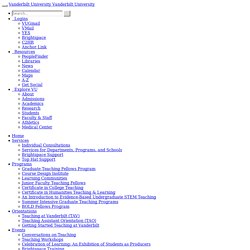
It is integrated as part of traditional courses, serves as a cornerstone of many blended courses, and is often the main information delivery mechanism in MOOCs. Several meta-analyses have shown that technology can enhance learning (e.g., Schmid et al., 2014), and multiple studies have shown that video, specifically, can be a highly effective educational tool (e.g., Kay, 2012; Allen and Smith, 2012; Lloyd and Robertson, 2012; Rackaway, 2012; Hsin and Cigas, 2013). In order for video to serve as a productive part of a learning experience, however, it is important for the instructor to consider three elements for video design and implementation: One of the primary considerations when constructing educational materials, including video, is cognitive load. Cognitive Load Theory, initially articulated by Sweller and colleagues (1988, 1989, 1994), suggests that memory has several components (see the figure).
Recommendations. How to Create a Learning Video They’ll Want to Watch. Hiring Mark Zuckerberg to deliver a workshop or run a retreat is not always the most practical or cost-effective solution.
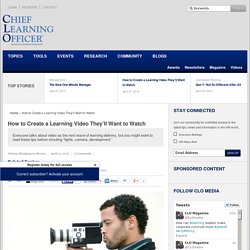
Know what’s not impractical? Bringing thousands of today’s industry leaders and visionaries to your employees through short-form video to share the lessons they’ve learned through triumphs and failures in their own careers. This kind of video-driven thought leadership education is an efficient way companies can adopt to scale best practices from visionaries who are out there right now, setting the pace in every industry. But watching a TED Talk on creativity and becoming a more creative problem-solver at work are two different things. 100+ Quick Tips for Flipping Your Class – Turn to Your Neighbor: The Official Peer Instruction Blog. Screencasting Feedback on Student Essays.
Last semester I was faced with a larger-than-usual senior composition class for English majors—which of course also meant a larger-than-usual feedback load.

With a new baby at home, I was more than a little concerned about finding the time to do it all. Fully aware of the research (e.g. Ferris, 1997; Hyland & Hyland, 2006) that favors more detailed feedback on student writing (seems “awkward: reword” just doesn’t cut it), I could not in good conscience consider reducing the quality or quantity of the feedback I usually give. Looking for ‘Flippable’ Moments in Your Class. “How do you determine what can be flipped?”
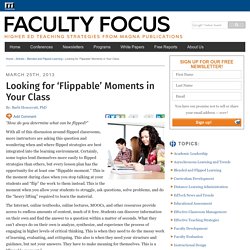
With all of this discussion around flipped classrooms, more instructors are asking this question and wondering when and where flipped strategies are best integrated into the learning environment. Certainly, some topics lend themselves more easily to flipped strategies than others, but every lesson plan has the opportunity for at least one “flippable moment.” This is the moment during class when you stop talking at your students and “flip” the work to them instead. This is the moment when you allow your students to struggle, ask questions, solve problems, and do the “heavy lifting” required to learn the material. The Internet, online textbooks, online lectures, MOOCs, and other resources provide access to endless amounts of content, much of it free.
How to Create Assessments for the Flipped Classroom. It seems like everyone is talking about the flipped classroom.
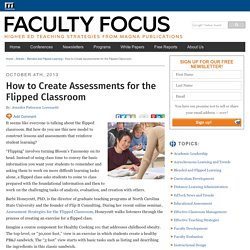
But how do you use this new model to construct lessons and assessments that reinforce student learning? “Flipping” involves turning Bloom’s Taxonomy on its head. Instead of using class time to convey the basic information you want your students to remember and asking them to work on more difficult learning tasks alone, a flipped class asks students to come to class prepared with the foundational information and then to work on the challenging tasks of analysis, evaluation, and creation with others. Barbi Honeycutt, PhD, is the director of graduate teaching programs at North Carolina State University and the founder of Flip It Consulting. During her recent online seminar, Assessment Strategies for the Flipped Classroom, Honeycutt walks listeners through the process of creating an exercise for a flipped class. The Flipped Classroom: Tips for Integrating Moments of Reflection. “Students in inverted classrooms need to have more space to reflect on their learning activities so that they can make necessary connections to course content” (Strayer, 2012).

If you were to observe a flipped classroom, what do you think would it look like? Maybe students are working in groups. Maybe each group is working on a different problem. Flipped Courses: A Few Concerns about the Rush to Flip. I have some concerns about flipping courses.
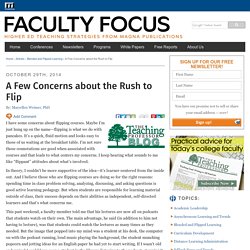
Maybe I’m just hung up on the name—flipping is what we do with pancakes. It’s a quick, fluid motion and looks easy to those of us waiting at the breakfast table. I’m not sure those connotations are good when associated with courses and that leads to what centers my concerns. I keep hearing what sounds to me like “flippant” attitudes about what’s involved. In theory, I couldn’t be more supportive of the idea—it’s learner-centered from the inside out. This past weekend, a faculty member told me that his lectures are now all on podcasts that students watch on their own. A Guide to the Flipped Classroom - Technology. Flipping Assessment: Making Assessment a Learning Experience.
If you’re a regular reader of this blog, you’re already aware that flipped instruction has become the latest trend in higher education classrooms.
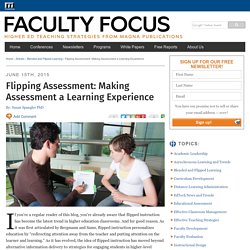
And for good reason. As it was first articulated by Bergmann and Sams, flipped instruction personalizes education by “redirecting attention away from the teacher and putting attention on the learner and learning.” As it has evolved, the idea of flipped instruction has moved beyond alternative information delivery to strategies for engaging students in higher-level learning outcomes. Four Assessment Strategies for the Flipped Learning Environment. Flipped learning environments offer unique opportunities for student learning, as well as some unique challenges.

By moving direct instruction from the class group space to the individual students’ learning spaces, time and space are freed up for the class as a learning community to explore the most difficult concepts of the course. Likewise, because students are individually responsible for learning the basics of new material, they gain regular experience with employing self-regulated learning strategies they would not have in an unflipped environment. But because initial engagement with new material is done independently as a preparation for class time rather than as its focus, many things could go wrong. If students do the assigned pre-class work but don’t acquire enough fluency with the basics—or if they simply don’t do it at all—then the in-class experience could be somewhere between lethargic and disastrous.
A key to achieving this kind of environment is assessment. Ready to Flip: Three Ways to Hold Students Accountable for Pre-Class Work - Faculty Focus. Five Ways to Motivate Unprepared Students in the Flipped Classroom. In the previous article “Ready to Flip: Three Ways to Hold Students Accountable for Pre-Class Work,” I mentioned that one of the most frequently asked questions about the flipped classroom model is, “How do you encourage students to actually do the pre-class work and come to class prepared?”
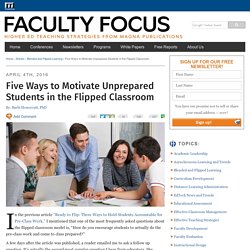
A few days after the article was published, a reader emailed me to ask a follow up question. It’s actually the second most popular question I hear from educators. She asked, “What do you do when students still aren’t coming to class prepared?” The flipped classroom model—or any active, student-centered learning model—relies heavily on students being prepared and ready to engage in the learning activities. If students are unprepared, then it limits what they can do, how deeply they can engage with the material, and how meaningfully they can connect with other students. Five Time-Saving Strategies for the Flipped Classroom. A few months ago, I heard a podcast by Michael Hyatt, a best-selling author and speaker who helps clients excel in their personal and professional lives. This particular podcast focused on how to “create margins” in life to reduce stress and avoid burnout.
Quoting Dr. Richard Swenson’s work, Hyatt defines a margin as “the space between our load and our limits. It is the amount allowed beyond that which is needed. . . . Margin is the gap between rest and exhaustion. . . . As I listened to this podcast, I realized that the idea of creating margins also applies to the flipped classroom. If these comments sound familiar, it might be helpful to create margins in your flipped classroom. Recommendation #1: Find flippable moments.Faculty interested in the flipped classroom get really excited about the flipped classroom. Teachers' Practical Guide to A FLipped Classroom. July, 2014 Unlike the numerous graphics I shared here on the topic of flipped learning which were substantially theoretically based, the one I have for you today provides a practical demonstration of how Dr.Russell flipped his classroom .
5 Flipped Classroom Issues (And Solutions) For Teachers. Have you been thinking about flipping your classroom this fall? Flipping can let you make the most of face-to-face time with your students. Rather than taking class time to introduce content and using homework to review concepts, flip the process so that students gain basic knowledge at home and then create, collaborate, and make connections in school. Creating video used to be out of reach for most teachers. Aaron Sams: The Flipped Classroom. The Flipped Classroom Model. Flipping the Classroom - Simply Speaking. Two Great Resources for Flipped Classrooms. The Great Flipped Classroom Debate: Advantages and Disadvantages. The Great Flipped Classroom Debate: Advantages and Disadvantages Flipped Classroom (Photo credit: ransomtech) Perhaps the only thing in the field of education which never changes…is the fact that it is always changing!
That is the very nature of education. These constant transformations are often accompanied by differing opinions and a lack of clarity which often takes a while to decipher. What one educator may see as a wonderful and groundbreaking idea or technique, others may perceive as totally without merit. The intention of this article is to examine the advantages and disadvantages of the flipped classroom. The Best Tools and Apps for Flipped Learning Classroom. July 25, 2014 Following the posting of "Managing iPad Videos in Schools" somebody emailed me asking about some suggestions for tools and apps to create instructional videos to use in a flipped learning setting. In fact, over the last couple of years I have reviewed several web tools and iPad apps that can be used in flipped classroom but the ones I am featuring below are among the best out there.
Flipped Classroom: Engaging Students with EdPuzzle. The flipped classroom model is a blended learning strategy I use to present my vocabulary, writing, and grammar instruction online. Learning Catalytics in class (Team-Based) Flipped Learning Certification Level - I. Jon Bergmann is one of the pioneers of the Flipped Class Movement.
Jon is leading the worldwide adoption of flipped learning by working with governments, schools, corporations, and education non-profits. Jon is coordinating or guiding flipped learning initiatives around the globe including China, Taiwan, Korea, Australia, Singapore, Thailand, the Middle East, Iceland, Sweden, Norway, the United Kingdom, Italy, Spain, Mexico, Canada, South America, and the United States. Mixing a MOOC with flip teaching in a traditional classroom - MOOC (Massive Open Online Course) Sergio Luján-Mora, Estela Saquete. Proceedings of the 5th International Conference on Education and New Learning Technologies (Edulearn 2013), p. 6480-6487, Barcelona (Spain), July 1-3 2013.
"She Didn’t Teach. We Had to Learn it Ourselves.” Yesterday I got an email from a faculty member who had just received her spring semester student ratings (yes, in August, but that’s a topic for another post). "She Didn’t Teach. We Had to Learn it Ourselves.” An Error Occurred Setting Your User Cookie. Blended and Flipped Learning Archives - Faculty Focus. June 15, 2015 Flipping Assessment: Making Assessment a Learning Experience By: Susan Spangler PhD If you’re a regular reader of this blog, you’re already aware that flipped instruction has become the latest trend in higher education classrooms.
Course Redesign Finds Right Blend of Content Delivery and Active Learning. Half of Faculty Say Their Job is More Difficult Today than Five Years Ago. If you find yourself working longer hours or maybe feeling a bit more stressed at the end of the day, you’re not alone. Fifty percent of college faculty who completed the annual Faculty Focus reader survey said that their job is more difficult than it was five years ago. Only nine percent said their job is less difficult, while 33 percent said it’s about the same.
For those who find their job more challenging, the reasons are wide-ranging. Flipped Classroom Survey Highlights Benefits and Challenges. Perhaps no other word has been as popular in higher education during the past few years as the term “flipped.” As a result, there is no shortage of ideas and opinions about flipped learning environments. Some faculty consider it another way to talk about student-centered learning. Others view flipped classrooms as an entirely new approach to teaching and learning. Five Ways to Motivate Unprepared Students in the Flipped Classroom. Four Assessment Strategies for the Flipped Learning Environment. The Maryland Flipped Classroom Study.
The Flipped Mastery Classroom in Action. Khan and Beyond: The Many Faces of the Flipped Classroom - Education Community Blog.